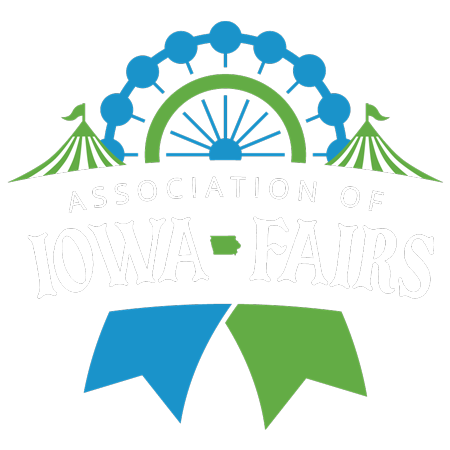About Us
Serving Iowa Fairs since 1907
The Association of Iowa Fairs (AIF) is a voluntary, non-profit corporation formed in 1907 with the intent of organizing the state, district, and county agricultural fairs of Iowa, festivals, associations, industry related businesses and individuals into one association that would focus on the improvement of fairs and related interests in Iowa.
Throughout the years, the AIF has held steadfast to its purpose of promoting and encouraging the development and improvement of the fair industry in Iowa, while focusing on the education of the youth of Iowa, and showcasing Iowa’s agricultural, industrial and domestic heritage.
Our mission is to preserve and strengthen the fair industry through our members and preserve the integrity of the fairs in Iowa.
- The AIF shall provide to its members legislative and educational information pertinent to the fair industry.
- The AIF shall provide assistance as needed to its members for the furtherance and benefit of its members.
- The AIF shall work to preserve and promote all of the youth programs of Iowa using the Fairs of Iowa as its medium.
- The AIF shall uphold the professional values of the fair industry and will strive to preserve the integrity of the Fairs in Iowa.
Associate Members
There are 150 Associate Members, including local festivals, chambers, artists, attractions, carnivals, agents, concessionaires and other businesses related to the fair industry.
Board of Directors
The Association of Iowa Fairs functions through a Board of Directors that consists of 12 District Directors, two from each of the six fair districts in Iowa.
Meetings
We host two district meetings in each of the six districts each year, one in the spring and one in the fall. The AIF also organizes its Conference and Annual Meeting, held yearly in December.
History of Fairs
Where and when the first fair was held is not known, however, evidence points to the existence of fairs as early as 500 BC Scripture records in the book of Ezekiel: "Tarshish was thy merchant by reason of the multitude of the kinds of riches with silver, iron, tin and lead, they traded in thy fairs." Ezekiel's account of the destruction of Tyre, supposedly written about 588 BC, describes Tyre as an important market and fair center.
It is equally clear that religious activity was companion to the commerce. The Latin world "feria" meaning holy day, would appear the logical root of the word "fair." Each feria was a day when large numbers of people would assemble for worship. Worship in those early days was centered around temples in great cities, including Ninevah, Athens, Rome and Mecca. These cities were also respected as the great commercial centers of the world. Fields adjacent to these temples were staked out for traders. Religious figures were placed about the fields in order to protect the traders and merchants.
During the early Christian era, the church took an active part in sponsoring fairs on feast days, and as a result, fairs came to be a source of revenue for the church. Possibly, our modern church bazaars possess some rudiments of these religious fairs.
This evolution which blended religion and commerce continued over time and moved into western Europe. Periodic gatherings brought together the producers of all types of commodities for the purpose of barter, exchange and, finally, outright sale. To this marketplace were added entertainment and other forms of activity thus, these primitive market took on the aspect of fairs as we know them today.
In 1765, less than 300 years after Columbus finished his work in the New World, the first American fair was presented in Windsor, Nova Scotia. The same fair continues to operate today. In upper Canada, as Ontario was known in early Confederation, a fair was held in 1792, sponsored by the Niagara Agricultural Society. As with Windsor, the Niagara Fair remains in operation today. In addition, many small fairs were held during the early 1700's in French Canada while under French rule.
Meanwhile, Elkanah Watson, a New England patriot and farmer, earned the title, "Father of US agricultural fairs" by producing (the first) a small exhibit of sheep under an old elm tree in the town of Pittsfield, Massachusetts. The year was 1807. He believed that the fine textured fleece of the exhibited sheep, when manufactured into cloth, would successfully compete with the best wool imported from England. He wrote, "Many farmers, and even women, were excited by curiosity to attend this first novel and humble exhibition."
In 1810 Watson staged a larger and more ambitious project, a Berkshire cattle show. The event was successful beyond all his expectations; entries included 386 sheep, 109 oxen, 9 cows, 7 folds, 3 heifers, 2 calves and 1 boar.
Early American fairs in both Canada and the US shifted quietly, but decisively away from the European festival model into the systematic development of agriculture and animal husbandry while offering education, local resource and local industry promotion and entertainment. Competition became the cornerstone of fair programming; youth development provided a social theme.
The nineteenth century closed with almost every state and province having one or more agricultural fair or exhibition.
Today, over 3,200 fairs are held in North America each year. They provide industrial exhibits, demonstrations and competition aimed at the advancement of livestock, horticulture and agriculture with special emphasis placed on educational activities such as 4-H, FFA and similar youth development programs. While enjoying these high-minded pursuits, fair visitors are also able to see, hear, touch, smell and taste the richness and variety of what the world has to offer.
